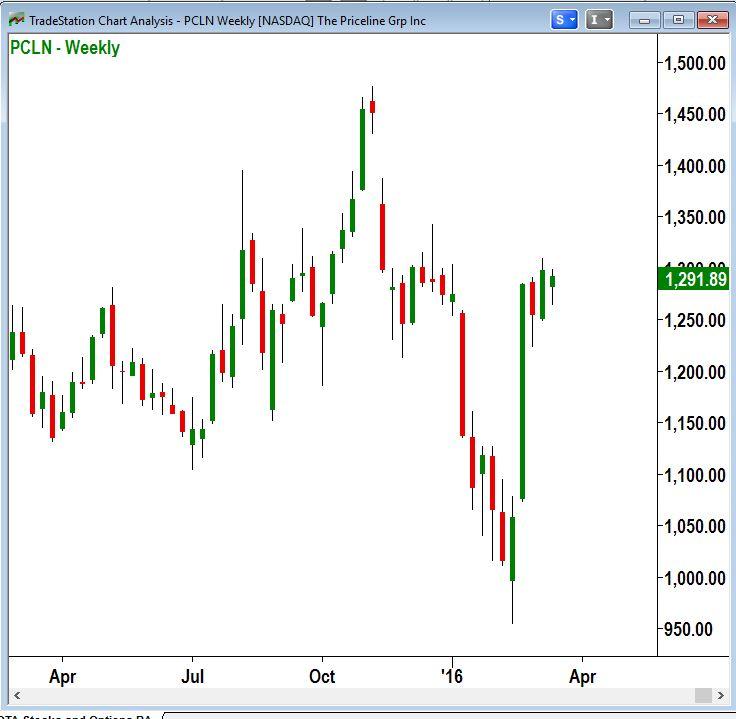Last week I described a way to use options as a way to trade high-priced stocks, like Google or Priceline, with much less cost and risk than trading the stocks themselves. Below is the chart of Priceline as of our starting point on March 9, 2016.
I compared two alternative trades to implement a bearish outlook:
Sell the stock short at the price at the time around $1292, with a target around $1100 and a stop-loss price at around $1310.
Buying a July put option at the $1300 strike, with orders in place to close out the trade if PCLN hit either our $1310 stop or $1100 target.
That article calculated that of the two trades, the put purchase had a potential to make 62% of the profit that the short stock sale would make if the stock reached the $1100 target; while tying up only 15% as much cash, for a much better cash-on-cash return. Today let’s look at using an additional option to improve the risk-reward possibilities even further.
At the time that we could have bought the $1300 put described before for $90.70 per share, we could have simultaneously sold a put near our $1100 target and received about $20.00 per share. Changing this trade from a simple long option into a vertical spread would do several things:
It would reduce the net cash out of pocket required to enter the trade, from $90.70 to $70.70 per share, since we would be collecting $20 per share for the short 1100-strike put.
If PCLN rallied to the $1310 stop-loss point, the loss would be less by about two dollars per share – about $14 per share instead of about $16 per share with the long put alone. This is because the short put would lose value in that case (good for us), and this would partially offset the loss in value of our long $1300-strike put.
If PCLN did drop down to the $1100 target, the profit on the trade would be about the same with or without the short put, if the decline took a long time. If it took a short time, the spread would not do quite as well as the long put alone.
Options at any moment in time may be cheap or expensive, in terms of the amount that traders are willing to pay per unit of time. This factor is dynamic – when expectations change, the option value per unit of time changes too. We call this factor implied volatility. When we simply own an option, we are fully exposed to those changes in expectations. When we are both short and long options at the same time, then our exposure to these changing expectations is diminished. In this case, options were a little on the cheap side, but not by much. Since they were not extremely cheap they could still get cheaper; so we would want to reduce our exposure to that possibility. Adding the short option to the long option offsets some of our exposure to a change in implied volatility.
Creating this vertical spread was one of a number of ways we could have matched our outlook on the stock’s price to an option strategy. Options can be put together like Lego blocks to create different types of positions for different situations. We can finely tune these positions in ways that are not possible with any other instrument. And, using options can give us entrée to trading in stocks that might otherwise be beyond our reach.
The selection of the right strategy is key to option profits. In our classes, we lay out a simple two-step process for selecting a strategy in any given situation. When you know how the pieces fit together, the puzzle becomes a picture.
This content is intended to provide educational information only. This information should not be construed as individual or customized legal, tax, financial or investment services. As each individual's situation is unique, a qualified professional should be consulted before making legal, tax, financial and investment decisions. The educational information provided in this article does not comprise any course or a part of any course that may be used as an educational credit for any certification purpose and will not prepare any User to be accredited for any licenses in any industry and will not prepare any User to get a job. Reproduced by permission from OTAcademy.com click here for Terms of Use: https://www.otacademy.com/about/terms
Editors’ Picks

EUR/USD struggles for direction amid USD gains
EUR/USD is trimming part of its earlier gains, coming under some mild downside pressure near 1.1730 as the US Dollar edges higher. Markets are still digesting the Fed’s latest rate decision, while also looking ahead to more commentary from Fed officials in the sessions ahead.

GBP/USD drops to daily lows near 1.3360
Disappointing UK data weighed on the Sterling towards the end of the week, triggering a pullback in GBP/USD to fresh daily lows near 1.3360. Looking ahead, the next key event across the Channel is the BoE meeting on December 18.

Gold losses momentum, challenges $4,300
Gold now gives away some gains and disputes the key $4,300 zone per troy ounce following earlier multi-week highs. The move is being driven by expectations that the Fed will deliver further rate cuts next year, with the yellow metal climbing despite a firmer Greenback and rising US Treasury yields across the board.

Litecoin Price Forecast: LTC struggles to extend gains, bullish bets at risk
Litecoin (LTC) price steadies above $80 at press time on Friday, following a reversal from the $87 resistance level on Wednesday. Derivatives data suggests a bullish positional buildup while the LTC futures Open Interest declines, flashing a long squeeze risk.

Big week ends with big doubts
The S&P 500 continued to push higher yesterday as the US 2-year yield wavered around the 3.50% mark following a Federal Reserve (Fed) rate cut earlier this week that was ultimately perceived as not that hawkish after all. The cut is especially boosting the non-tech pockets of the market.
RECOMMENDED LESSONS
Making money in forex is easy if you know how the bankers trade!
I’m often mystified in my educational forex articles why so many traders struggle to make consistent money out of forex trading. The answer has more to do with what they don’t know than what they do know. After working in investment banks for 20 years many of which were as a Chief trader its second knowledge how to extract cash out of the market.
5 Forex News Events You Need To Know
In the fast moving world of currency markets where huge moves can seemingly come from nowhere, it is extremely important for new traders to learn about the various economic indicators and forex news events and releases that shape the markets. Indeed, quickly getting a handle on which data to look out for, what it means, and how to trade it can see new traders quickly become far more profitable and sets up the road to long term success.
Top 10 Chart Patterns Every Trader Should Know
Chart patterns are one of the most effective trading tools for a trader. They are pure price-action, and form on the basis of underlying buying and selling pressure. Chart patterns have a proven track-record, and traders use them to identify continuation or reversal signals, to open positions and identify price targets.
7 Ways to Avoid Forex Scams
The forex industry is recently seeing more and more scams. Here are 7 ways to avoid losing your money in such scams: Forex scams are becoming frequent. Michael Greenberg reports on luxurious expenses, including a submarine bought from the money taken from forex traders. Here’s another report of a forex fraud. So, how can we avoid falling in such forex scams?
What Are the 10 Fatal Mistakes Traders Make
Trading is exciting. Trading is hard. Trading is extremely hard. Some say that it takes more than 10,000 hours to master. Others believe that trading is the way to quick riches. They might be both wrong. What is important to know that no matter how experienced you are, mistakes will be part of the trading process.
The challenge: Timing the market and trader psychology
Successful trading often comes down to timing – entering and exiting trades at the right moments. Yet timing the market is notoriously difficult, largely because human psychology can derail even the best plans. Two powerful emotions in particular – fear and greed – tend to drive trading decisions off course.

